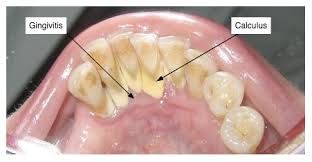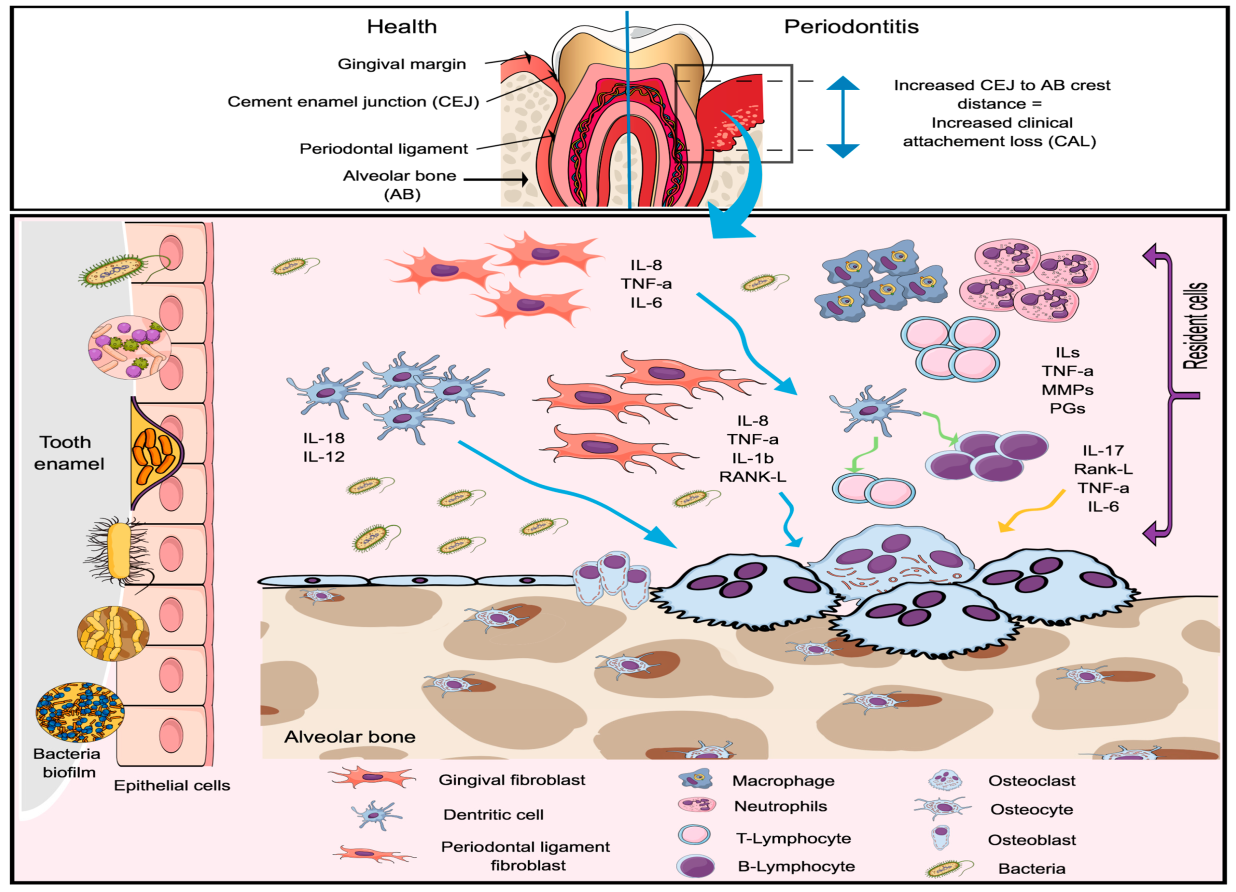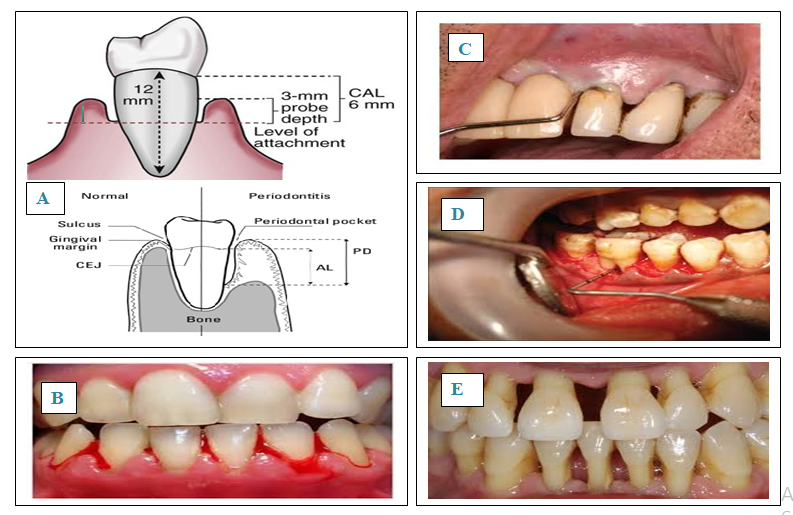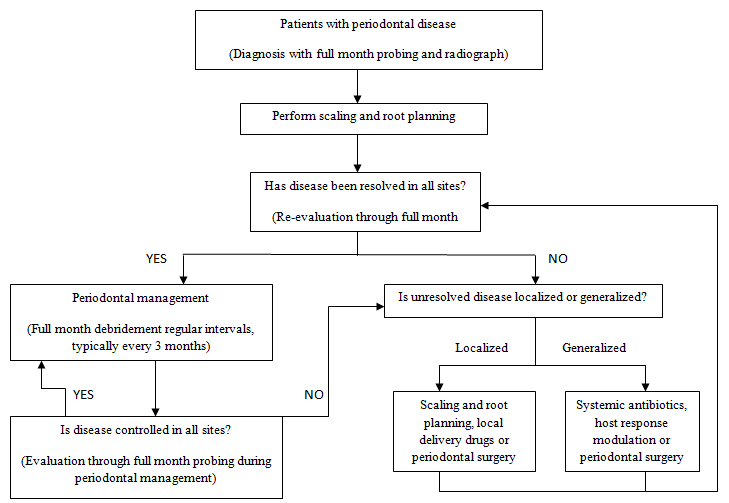Background
Periodontitis is an infection of Periodontium. Whereas, the word ‘Perio’ means gingiva and other tissues surrounding teeth, ‘dont’ mean tooth and ‘itis’ means inflammation, So the whole term “Periodontitis” indicates chronic inflammation of gingiva1 periodontal ligaments, alveolar bone and dental cementum. According to World Health Organization (WHO) it is widely spreadable chronic disease around the world.2 It begins with accumulation of plaque around teeth which form microbial biofilms with bacteria followed by localized inflammation of gingiva. Negligence of this situation causes chronic condition of periodontal disease. At this stage damage of periodontal structure occurs by baleful byproducts and enzyme from periodontal bacteria such as leucotoxins, collagenase, fibrinolysis and other Bacteroids spp.: B. intermedius and B. gingivalis, fusiform organisms: Actinobacillus actinomycetemcomitans, Wollina recta and Eikenella spp.; Porphyromonas gingivalis, Taneerella for synthesis and various bacilli and cocci; spirochetes; and amoebas and trichomonads.3, 4, 5
By maintaining good oral hygiene, it can be reversed at initial stage but if plaque is not removed at this stage then formation of tartar or calculus occur which is not removable by using tooth brush or floss. Because of this tartar, bacteria start attacking deeper tissues due to which periodontal ligaments around teeth gets degraded and leads to resorption of alveolar bone.6 A space between gingiva and tooth occurs which is referred as “Periodontal Pocket” and this condition is mainly known as periodontitis or periodontal disease. The severity of this disease depends upon microbial plaque formation.7
The screening and examination of this disease has been done by various methods, which results in detection of severity of periodontal ligament. Several tests are there to diagnose the periodontal disease such as radiograph technique, hematological screening, laser treatment, tissue engineering, etc. To control the progression of disease there are many treatment options available (surgical as well as non-surgical) depend upon the chronology of disease. The maintenance of this disease is done by intensive care and by sustaining good oral hygiene.8, 9
Stages
There are mainly four stages in periodontal diseases which includes different clinical sign & symptoms and radiological screening are given as follows:10, 11, 12
Gingivitis
It is the only stage when periodontitis can be reversible. At this stage the plaque formation around teeth occurs. There are mainly few painless symptoms seen at this stage such as bad breath, swollen reddish gums and bleeding while brushing and flossing. It can be reversed by maintaining good oral hygiene and regular checkups. Generally, 1-2 mm clinical attachment loss, less than 15% of bone loss around root, probing depth 4mm or less occurs.
Early stage
It is the second stage of periodontal disease. It is manageable by oral hygiene but not reversible. At this stage, the infection starts spreading to surrounding tissues and starts degrading it. Symptoms at this stage include inflammation of gums, severe bad breath, and bleeding during brushing or flossing, spacing between teeth become evident and will gradually increase. Here, 3-4 mm clinical attachment loss, less than 15-33% of bone loss around root, probing depth 5mm or less occurs.
Moderate stage
Like second stage moderate stage cannot be reversed. Same symptoms as moderate stage occurs but space between teeth and recessions of gums are more evident. Treatment like deep cleaning, scaling and flap surgeries can be done at this stage. Around5 mm or more clinical attachment loss, 33% of tooth loss of four teeth or less, with complex issues such as probing depth 6 mm or more, Class II-III furcations, and/or moderate ridge defects.
Advanced stage
Last stage of periodontal disease; wherein 50-90% of loss of periodontal tissues occurs. Also other symptoms like swollen gums that ooze of pus, cold sensitivity, loosening of teeth, painful chewing and severe halitosis occurs. If left untreated it causes more spaces or gaps between teeth and gums, gum recession, patient needling dentures, and other health problems that can be worst. Treatment includes regular checkups, cleaning and maintaining good oral hygiene can help halt the progression of Periodontitis. Secondary Occlusal trauma, severe ridge defects, bite collapse, pathologic migration of teeth, less than 20 remaining teeth (10 opposing pairs) seen.
Types of Periodontitis15, 16, 17, 18
Gingivitis
As described above, gingivitis is inflammation of gums and can be reversed by maintaining oral hygiene.
Chronic periodontitis
In this type of periodontal disease, symptoms may include chronic inflammation of gums, severe bad breath, and bleeding during brushing or flossing occurs. Loss of epithelial tissue, bone and ligaments which is not reversible.
Aggressive periodontitis
It can be present in localized or generalized forms, both are early onset form of chronic periodontal inflammatory disease, typical manifesting between puberty and early third decade of life. The symptoms are same as chronic periodontitis.
Necrotizing ulcerative gingivitis
It is mainly occurring in people who are suffering from malnutrition, immune suppressive and HIV. Necrosis means death of cell or living tissue. It mainly occurs due to deficiency of nourishment needed by people to remain healthy.
Systemic chronic periodontitis
This type of chronic periodontal disease happens in patient who have systemic syndrome. Inflammation of gums occurs due to systemic disease such as Diabetes, Heart disease, Respiratory disease, etc.
Figure 3
Clinical photographs illustrating the severity of the disease (BOP: Bleeding on probing; PPD: probing pocket depth; CAL: Clinical attachment loss). Reprinted with permission.19 Copyright 2019. Journal of Control Release.

Occurance & Epidemiology
Periodontal disease is mostly prevalent in adults but it may also occur in children and adolescents.20 Prevalence of periodontal diseases depends upon the level of dental plaque formation and gingival tissue destruction. Site specificity is one of the key features for chronic and aggressive periodontitis. The severity of this disease depend upon depth of periodontal pocket i.e. attachment loss and bone loss of tooth.21
The epidemiology of periodontitis may vary across masses substantially. Frequently used parameters to collect data for occurrence of this disease are clinical attachment loss and probing depth of periodontal pockets which was first introduced by US centers for Disease Control Prevention and American Academy of Periodontology.22
Various studies were conducted by researchers to find out prevalence rate in different countries. Globally 10-15% of populations are suffering from tooth loss due to periodontal disease.23 A study was conducted in Gautemala by Dowsett et al in 2001 reported that out of 122 patients, attachment loss was found about 3 and 6 mm in 100% and 56% of overall individuals respectively.24 Afterwards in 2003, another clinical study by A. Baelum et al. reported that out of 359 patients of rural Thai population, 92% were diagnosed with higher prevalence of periodontitis due to genetic variation within age group of 30-32 years individuals.25 Also in 2017, another study was conducted in South India among 1000 individuals which showed prevalence rate of chronic periodontitis among different strata of sample populations (Table 1).26 Similarly, another clinical study conducted by researchers in 2018 about prevalence rate of periodontitis among different age group of people of South India (Figure 4).27
Table 1
Prevalence rate in different strata of sample population
Risk factor
There are two kind of risk factor in case of periodontal disease out of which one is modifiable and another is non-modifiable.28 Cigarette smoking is one of the vital modifiable risk factor for chronic periodontal disease. Higher progression of microbial film is severe in smokers than nonsmokers and more worsen chronic condition occurs due to habit of smoking.29 Most prevalent systemic disease is diabetes mellitus predispose to periodontitis. In diabetic patient, prevalence of periodontitis occurs more readily as compared to other immunocompromised patients.30 Stress is also another consideration as immunosupression and necrotizing ulcerative gingivitis occurs mainly due to stress.31 There are many risk factors associated with this disease are given as (Table 2).
Table 2
Types of risk factor in periodontitis
Pathophysiology
The dental plaque or calculus
Periodontitis and gingivitis are mainly initiated with dental plaque. There are around 150 species of microbes are found in single person and overall 800 different types of species of microbes have been identified in calculus of tooth. The species include Gram negative anaerobic bacteria, spirochete and even virus. The imbalance between these microbes forms ‘pathogenic unit’ in case of chronic periodontal disease.32
Figure 5
Dental plaque or calculus. Reprinted with permission.33 Copyright 2013. International Journal of Medical Dentistry.

Microbial biofilms
As we discussed earlier, microbial biofilm initiates gingivitis. The progression of microbial biofilm depends upon dysbiotic ecological changes in baleful byproducts and enzyme which results in degradation of periodontal tissue. Microbial biofilms are kind of matrix fixed with different microbial species colony, sticking with each other on tooth surface.34 There are seven stages of plaque biofilm formation are given as (Table 3).
Table 3
Stages of microbial biofilm formation35
Immunogenicity
Not only microbial films are responsible for pathogenesis of periodontal disease but also host cells immune system is responsible for degradation of periodontal ligaments.36 The balance between microbial biofilm and host cell is lost due to which remarkable variance in both dental plaque and host immunity system occurs, which results in increment of inflammatory cells leads to degradation of periodontal tissue and bone.37 Therefore decrease of anti-inflammatory cells such as neutrophils, lymphocytes, granulocytes, etc. due to chronic persistence of microbial biofilms which results in severity of alveolar bone resorption by osteoclast and leads to degradation of ligament fibers followed by chronic periodontitis.38
Figure 6
Immune response in periodontal disease. Reprinted with permission from ref.39 Copyright 2017. Journal of Clinical Periodontology.

Periodontal Screening and Examination40, 41
The dental examination starts with an extra cellular and intra cellular oral examination of soft and hard tissues. The periodontal examination includes these following steps as follows:
Detailed examination of ligament degradation and periodontal pocket depth as:
Probing depth of periodontal pocket, attachment loss and recession
Bleeding.
Suppuration.
Furcation involvement.
Mobility of tooth.
Figure 7
A: Probing depth of periodontal pocket.,42 B: Gingival bleeding.43, C: Suppuration.43, D: Furcation involvement.44 E: Mobility of tooth.44

All these parameters are measured on six sites per tooth such as mesiobuccal, buccal, distobuccal, mesiolingual, midlingual and distolingual. And all these readings are recorded in periodontal chart.
Diagnosis45, 46, 47
Diagnosis of periodontal disease has been done by following investigations are given as:
Radiograph
Periapical radiograph, Bitewing radiographs, Panoramic X-ray or combination of all these is used to diagnose the prognosis of patients.
Radiograph provides detailed information about patient’s tooth condition. The degree of bone loss and depth of periodontal pocket can be assessed by using Radiograph and also pattern and amount of bone loss.
Table 4
Types of radiograph and their parameters
Treatment and Management
Treatment plan for periodontal disease are divided into three phases as follows:
Initial therapy
This therapy is given at initial stage of gingivitis to control the microbial plaque formation and identify any modifiable risk factor.48 Giving advice to the patients regarding oral hygiene technique, cessation of habits like smoking, alcohol consumption, chewing pan masala, etc. and also doctors gives instruction regarding type of toothbrush to be use, use of interdental aids, dentifrices or mouthwash, etc.49 If periodontal risk factors like Diabetes mellitus identified then patient should be advised accordingly. The therapy is revaluated after 8-12 weeks because 6 weeks is minimum period for healing of tissue or periodontal ligaments. The initial treatment includes following therapies:
Tooth brushing
Manual and electronic toothbrush are available to remove dental plaque. Robinson et al in 2005 reported in this study that oscillating, rotating, powered toothbrush shows more efficiency in removing dental plaque.50
Interdental cleaning
An effective toothbrush can clean only 65% of tooth surface but do not remove overall dental plaque, so interdental cleaning is also necessary to clean the microbial biofilms such as dental floss, tape and powered flossing device. When interdental papillae completely embrasure then dental floss and tape are advised to the patient which helps to improved periodontal clinical outcomes.51 (Figure 9 )
Adjunctive pharmacological agent
Many Pharmaceutical aids have been added into mouthwashes and toothpaste to increase the efficiency of the product. Widely used agent like Chlorhexidine Gluconate is considered as gold standard anti-plaque/ anti-gingivitis agent.52 It is mainly added into mouth wash, gel or toothpaste. There are various examples of adjunctive aids are given as (Table 5).
Table 5
Adjunctive pharmacological agents
Non-surgical treatment:53, 54
At initial stage of gingivitis, the treatment may be less aggressive as given as:
Scaling
Scaling helps to remove calculus and microbial biofilms from gums. It may be operated by using hand instruments or by ultrasonic device.
Root planning
Root planning helps to smooth the root surface and also inhibiting further buildup of tartar. It also removes baleful byproducts to reduce the inflammation and increase healing of attachment of gums to tooth surface.
Antibiotics
Topical or Oral antibiotics are used to control the formation of microbial biofilms. Topical antibiotics such as insertion or gels or implants etc. are inserted in gingival sulcus or in periodontal pockets. However, Oral antibiotics eliminate infection caused by bacteria on gums and teeth surfaces.
Table 6
Examples of surgical Treatments
Corrective therapy or surgical treatments55, 56, 57, 58
There are several surgical treatments to treat periodontal disease (Table 6).
Supportive therapy
This therapy is suggested for prevention of recurrence of disease and also sustenance of periodontal health.59 This therapy includes regular check-ups of the patient, to monitor the periodontal status and to re-educate to the patient regarding plaque control measures and oral hygiene maintenance.60
Management: Periodontal disease has capacity to control the progression of disease and inhibit the growth of microorganisms. However, the success of therapy for periodontal disease depends upon appropriate management with proper treatments.61 The management of periodontal disease consists of removal of supra-gingival and sub-gingival dental plaque followed by healing in tooth loss.62 In general it takes around 3 months of treatment interval to control the chronicity of periodontal disease. Maintenance period has been customized depends upon severity of disease. Supportive therapy aims long term maintenance of disease, so proper measures are taken to improve the compliances of management by patients to control the disease progression.63 Management plan for periodontal disease includes Figure 10.
Clinical Significance
There has been known direct and indirect impact on overall general health due to oral health. This study helps to improve researcher’s knowledge regarding periodontal diseases. Due to rapidly increase of progression and aggressiveness of this disease, patients requires early diagnosis and treatment to prevent from further progression and tissue damage. With the growing advancement in etiopathogenesis of this disease, there have been exponential increments in novel treatment strategies. There are various treatment modalities available for treatment of periodontal diseases. A thorough diagnosis and treatment planning is important for the management of patient to reduce the chronicity of this disease.






